Communication in a Business Environment: ALDI Report
VerifiedAdded on 2020/07/23
|11
|3270
|85
Report
AI Summary
This report provides a comprehensive analysis of business communication strategies within the context of ALDI, a retail company. It begins by examining the communication needs of internal and external stakeholders, differentiating between formal and informal communication styles. The report then explores various communication models, such as the Shannon and Weaver model and Berlo's model, evaluating the effectiveness of different communication systems like email and telephone. It delves into the factors influencing the choice of communication media, the importance of correct grammar and structure, and ways to overcome communication barriers. The report also covers the use of communication theories, body language, and proofreading techniques. Furthermore, it discusses the purpose and audience of communication, appropriate media selection, and the importance of adhering to agreed business practices. Finally, it examines the purpose and benefits of meeting deadlines and the effective use of language and body language in verbal communication, reinforcing the importance of clear and concise communication in a business environment. The report concludes by summarizing the key findings and emphasizing the importance of effective communication for business success.
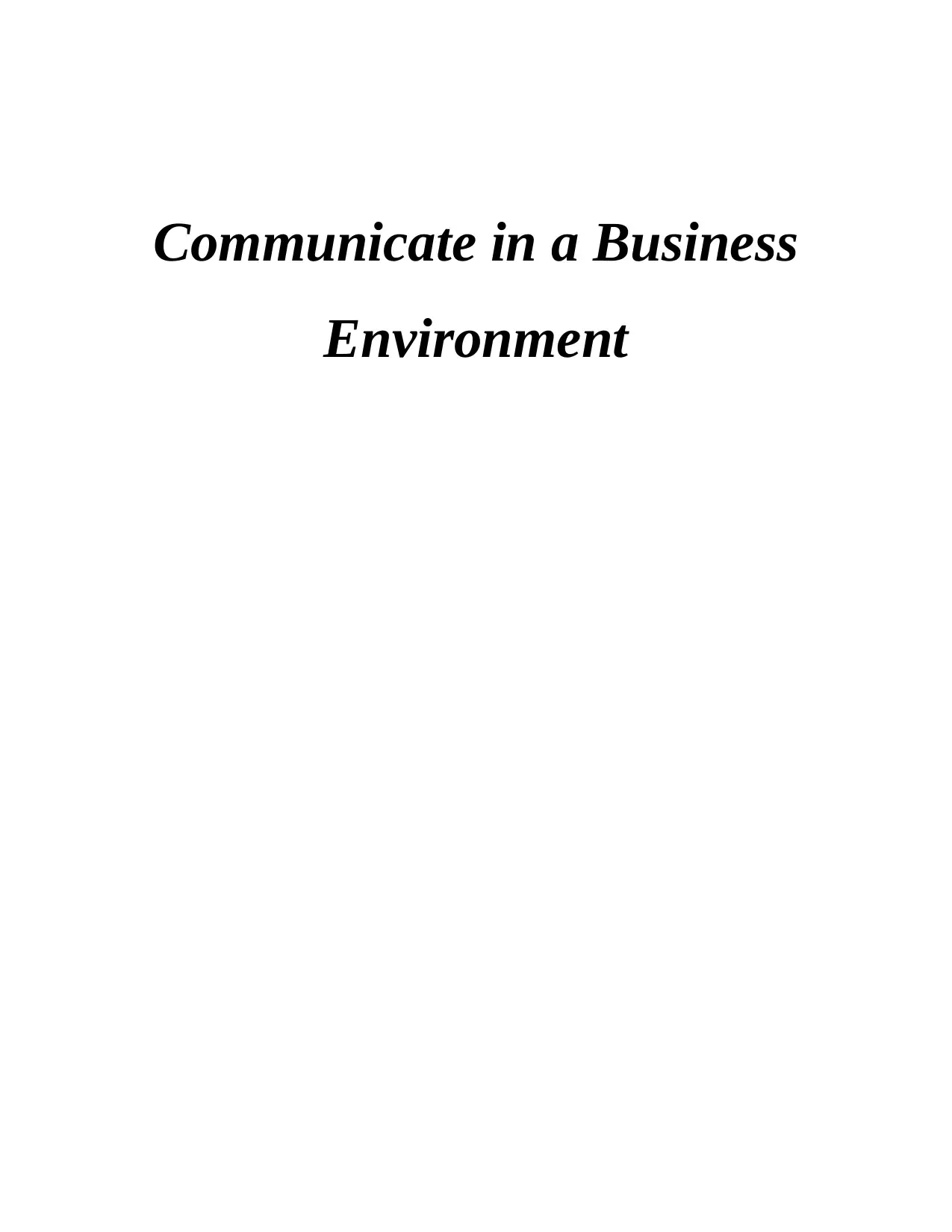
Communicate in a Business
Environment
Environment
Paraphrase This Document
Need a fresh take? Get an instant paraphrase of this document with our AI Paraphraser
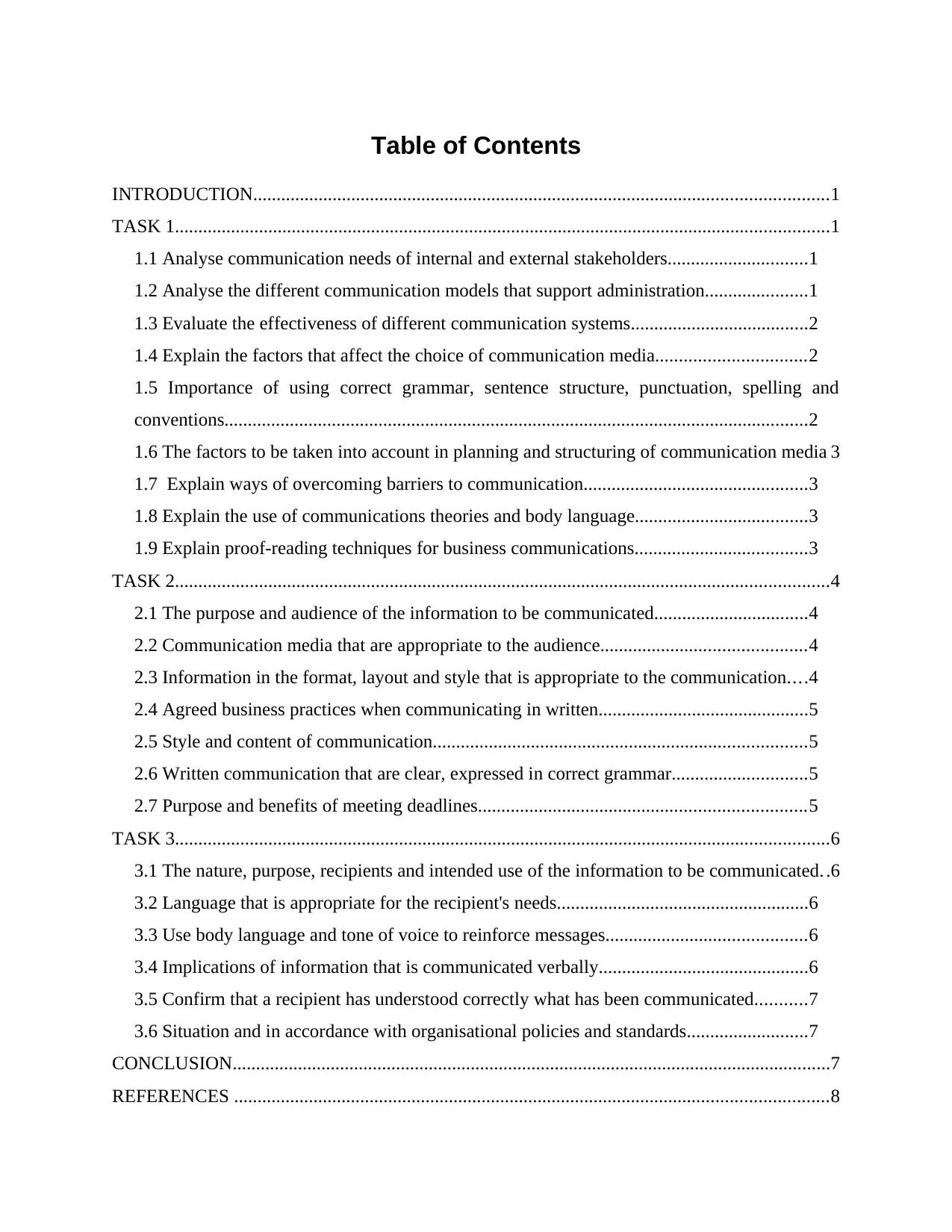
Table of Contents
INTRODUCTION...........................................................................................................................1
TASK 1............................................................................................................................................1
1.1 Analyse communication needs of internal and external stakeholders..............................1
1.2 Analyse the different communication models that support administration......................1
1.3 Evaluate the effectiveness of different communication systems......................................2
1.4 Explain the factors that affect the choice of communication media................................2
1.5 Importance of using correct grammar, sentence structure, punctuation, spelling and
conventions.............................................................................................................................2
1.6 The factors to be taken into account in planning and structuring of communication media 3
1.7 Explain ways of overcoming barriers to communication................................................3
1.8 Explain the use of communications theories and body language.....................................3
1.9 Explain proof-reading techniques for business communications.....................................3
TASK 2............................................................................................................................................4
2.1 The purpose and audience of the information to be communicated.................................4
2.2 Communication media that are appropriate to the audience............................................4
2.3 Information in the format, layout and style that is appropriate to the communication....4
2.4 Agreed business practices when communicating in written.............................................5
2.5 Style and content of communication................................................................................5
2.6 Written communication that are clear, expressed in correct grammar.............................5
2.7 Purpose and benefits of meeting deadlines......................................................................5
TASK 3............................................................................................................................................6
3.1 The nature, purpose, recipients and intended use of the information to be communicated. .6
3.2 Language that is appropriate for the recipient's needs......................................................6
3.3 Use body language and tone of voice to reinforce messages...........................................6
3.4 Implications of information that is communicated verbally.............................................6
3.5 Confirm that a recipient has understood correctly what has been communicated...........7
3.6 Situation and in accordance with organisational policies and standards..........................7
CONCLUSION................................................................................................................................7
REFERENCES ...............................................................................................................................8
INTRODUCTION...........................................................................................................................1
TASK 1............................................................................................................................................1
1.1 Analyse communication needs of internal and external stakeholders..............................1
1.2 Analyse the different communication models that support administration......................1
1.3 Evaluate the effectiveness of different communication systems......................................2
1.4 Explain the factors that affect the choice of communication media................................2
1.5 Importance of using correct grammar, sentence structure, punctuation, spelling and
conventions.............................................................................................................................2
1.6 The factors to be taken into account in planning and structuring of communication media 3
1.7 Explain ways of overcoming barriers to communication................................................3
1.8 Explain the use of communications theories and body language.....................................3
1.9 Explain proof-reading techniques for business communications.....................................3
TASK 2............................................................................................................................................4
2.1 The purpose and audience of the information to be communicated.................................4
2.2 Communication media that are appropriate to the audience............................................4
2.3 Information in the format, layout and style that is appropriate to the communication....4
2.4 Agreed business practices when communicating in written.............................................5
2.5 Style and content of communication................................................................................5
2.6 Written communication that are clear, expressed in correct grammar.............................5
2.7 Purpose and benefits of meeting deadlines......................................................................5
TASK 3............................................................................................................................................6
3.1 The nature, purpose, recipients and intended use of the information to be communicated. .6
3.2 Language that is appropriate for the recipient's needs......................................................6
3.3 Use body language and tone of voice to reinforce messages...........................................6
3.4 Implications of information that is communicated verbally.............................................6
3.5 Confirm that a recipient has understood correctly what has been communicated...........7
3.6 Situation and in accordance with organisational policies and standards..........................7
CONCLUSION................................................................................................................................7
REFERENCES ...............................................................................................................................8

⊘ This is a preview!⊘
Do you want full access?
Subscribe today to unlock all pages.

Trusted by 1+ million students worldwide
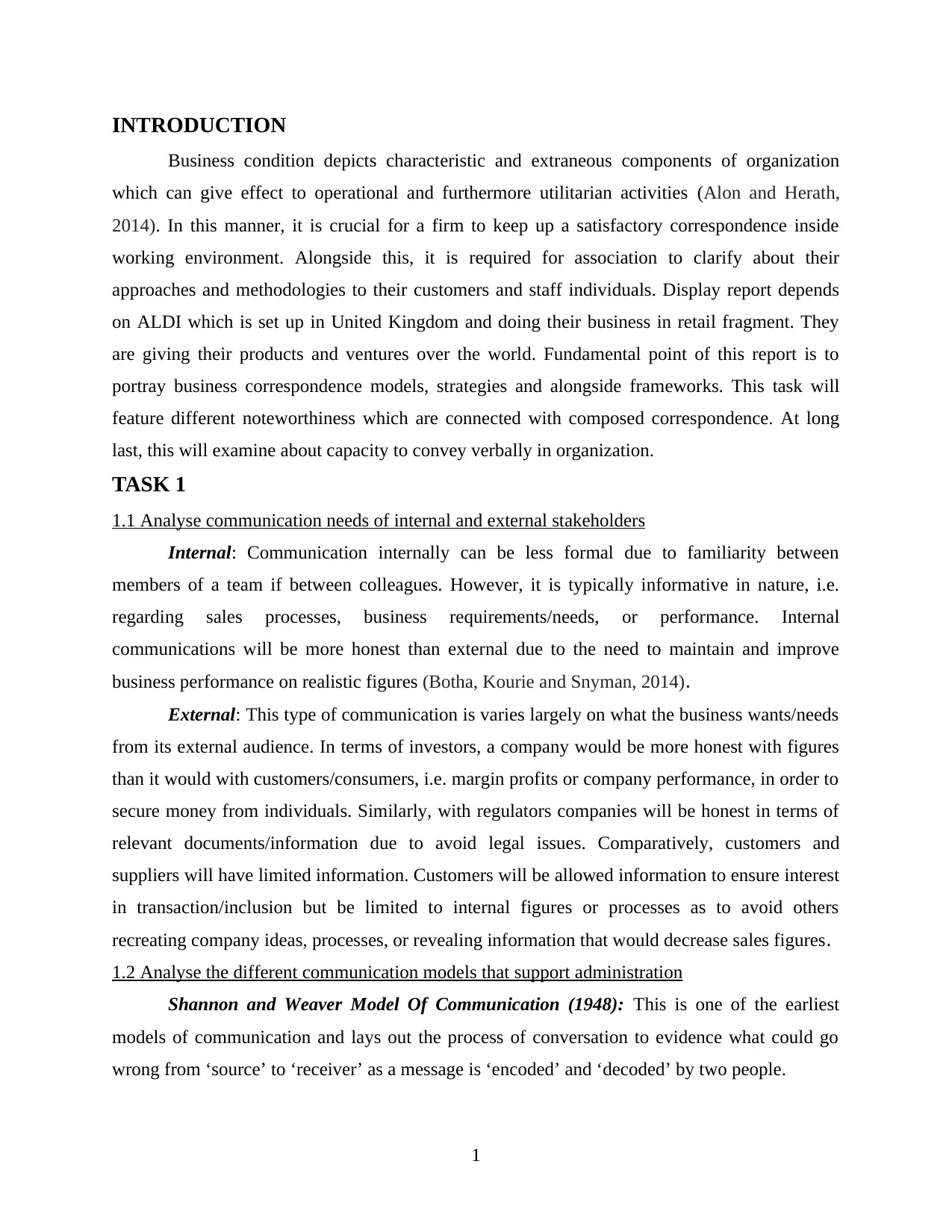
INTRODUCTION
Business condition depicts characteristic and extraneous components of organization
which can give effect to operational and furthermore utilitarian activities (Alon and Herath,
2014). In this manner, it is crucial for a firm to keep up a satisfactory correspondence inside
working environment. Alongside this, it is required for association to clarify about their
approaches and methodologies to their customers and staff individuals. Display report depends
on ALDI which is set up in United Kingdom and doing their business in retail fragment. They
are giving their products and ventures over the world. Fundamental point of this report is to
portray business correspondence models, strategies and alongside frameworks. This task will
feature different noteworthiness which are connected with composed correspondence. At long
last, this will examine about capacity to convey verbally in organization.
TASK 1
1.1 Analyse communication needs of internal and external stakeholders
Internal: Communication internally can be less formal due to familiarity between
members of a team if between colleagues. However, it is typically informative in nature, i.e.
regarding sales processes, business requirements/needs, or performance. Internal
communications will be more honest than external due to the need to maintain and improve
business performance on realistic figures (Botha, Kourie and Snyman, 2014).
External: This type of communication is varies largely on what the business wants/needs
from its external audience. In terms of investors, a company would be more honest with figures
than it would with customers/consumers, i.e. margin profits or company performance, in order to
secure money from individuals. Similarly, with regulators companies will be honest in terms of
relevant documents/information due to avoid legal issues. Comparatively, customers and
suppliers will have limited information. Customers will be allowed information to ensure interest
in transaction/inclusion but be limited to internal figures or processes as to avoid others
recreating company ideas, processes, or revealing information that would decrease sales figures.
1.2 Analyse the different communication models that support administration
Shannon and Weaver Model Of Communication (1948): This is one of the earliest
models of communication and lays out the process of conversation to evidence what could go
wrong from ‘source’ to ‘receiver’ as a message is ‘encoded’ and ‘decoded’ by two people.
1
Business condition depicts characteristic and extraneous components of organization
which can give effect to operational and furthermore utilitarian activities (Alon and Herath,
2014). In this manner, it is crucial for a firm to keep up a satisfactory correspondence inside
working environment. Alongside this, it is required for association to clarify about their
approaches and methodologies to their customers and staff individuals. Display report depends
on ALDI which is set up in United Kingdom and doing their business in retail fragment. They
are giving their products and ventures over the world. Fundamental point of this report is to
portray business correspondence models, strategies and alongside frameworks. This task will
feature different noteworthiness which are connected with composed correspondence. At long
last, this will examine about capacity to convey verbally in organization.
TASK 1
1.1 Analyse communication needs of internal and external stakeholders
Internal: Communication internally can be less formal due to familiarity between
members of a team if between colleagues. However, it is typically informative in nature, i.e.
regarding sales processes, business requirements/needs, or performance. Internal
communications will be more honest than external due to the need to maintain and improve
business performance on realistic figures (Botha, Kourie and Snyman, 2014).
External: This type of communication is varies largely on what the business wants/needs
from its external audience. In terms of investors, a company would be more honest with figures
than it would with customers/consumers, i.e. margin profits or company performance, in order to
secure money from individuals. Similarly, with regulators companies will be honest in terms of
relevant documents/information due to avoid legal issues. Comparatively, customers and
suppliers will have limited information. Customers will be allowed information to ensure interest
in transaction/inclusion but be limited to internal figures or processes as to avoid others
recreating company ideas, processes, or revealing information that would decrease sales figures.
1.2 Analyse the different communication models that support administration
Shannon and Weaver Model Of Communication (1948): This is one of the earliest
models of communication and lays out the process of conversation to evidence what could go
wrong from ‘source’ to ‘receiver’ as a message is ‘encoded’ and ‘decoded’ by two people.
1
Paraphrase This Document
Need a fresh take? Get an instant paraphrase of this document with our AI Paraphraser
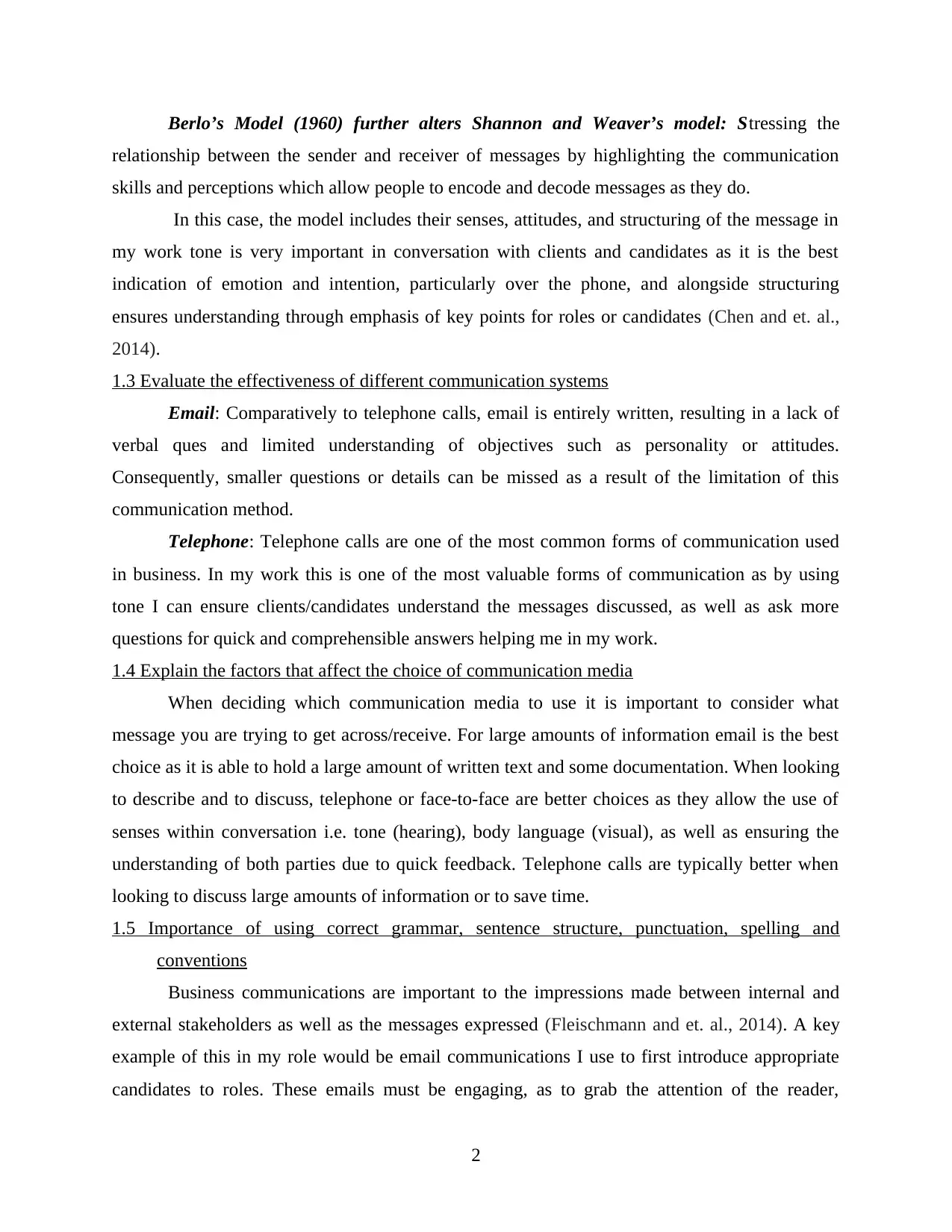
Berlo’s Model (1960) further alters Shannon and Weaver’s model: Stressing the
relationship between the sender and receiver of messages by highlighting the communication
skills and perceptions which allow people to encode and decode messages as they do.
In this case, the model includes their senses, attitudes, and structuring of the message in
my work tone is very important in conversation with clients and candidates as it is the best
indication of emotion and intention, particularly over the phone, and alongside structuring
ensures understanding through emphasis of key points for roles or candidates (Chen and et. al.,
2014).
1.3 Evaluate the effectiveness of different communication systems
Email: Comparatively to telephone calls, email is entirely written, resulting in a lack of
verbal ques and limited understanding of objectives such as personality or attitudes.
Consequently, smaller questions or details can be missed as a result of the limitation of this
communication method.
Telephone: Telephone calls are one of the most common forms of communication used
in business. In my work this is one of the most valuable forms of communication as by using
tone I can ensure clients/candidates understand the messages discussed, as well as ask more
questions for quick and comprehensible answers helping me in my work.
1.4 Explain the factors that affect the choice of communication media
When deciding which communication media to use it is important to consider what
message you are trying to get across/receive. For large amounts of information email is the best
choice as it is able to hold a large amount of written text and some documentation. When looking
to describe and to discuss, telephone or face-to-face are better choices as they allow the use of
senses within conversation i.e. tone (hearing), body language (visual), as well as ensuring the
understanding of both parties due to quick feedback. Telephone calls are typically better when
looking to discuss large amounts of information or to save time.
1.5 Importance of using correct grammar, sentence structure, punctuation, spelling and
conventions
Business communications are important to the impressions made between internal and
external stakeholders as well as the messages expressed (Fleischmann and et. al., 2014). A key
example of this in my role would be email communications I use to first introduce appropriate
candidates to roles. These emails must be engaging, as to grab the attention of the reader,
2
relationship between the sender and receiver of messages by highlighting the communication
skills and perceptions which allow people to encode and decode messages as they do.
In this case, the model includes their senses, attitudes, and structuring of the message in
my work tone is very important in conversation with clients and candidates as it is the best
indication of emotion and intention, particularly over the phone, and alongside structuring
ensures understanding through emphasis of key points for roles or candidates (Chen and et. al.,
2014).
1.3 Evaluate the effectiveness of different communication systems
Email: Comparatively to telephone calls, email is entirely written, resulting in a lack of
verbal ques and limited understanding of objectives such as personality or attitudes.
Consequently, smaller questions or details can be missed as a result of the limitation of this
communication method.
Telephone: Telephone calls are one of the most common forms of communication used
in business. In my work this is one of the most valuable forms of communication as by using
tone I can ensure clients/candidates understand the messages discussed, as well as ask more
questions for quick and comprehensible answers helping me in my work.
1.4 Explain the factors that affect the choice of communication media
When deciding which communication media to use it is important to consider what
message you are trying to get across/receive. For large amounts of information email is the best
choice as it is able to hold a large amount of written text and some documentation. When looking
to describe and to discuss, telephone or face-to-face are better choices as they allow the use of
senses within conversation i.e. tone (hearing), body language (visual), as well as ensuring the
understanding of both parties due to quick feedback. Telephone calls are typically better when
looking to discuss large amounts of information or to save time.
1.5 Importance of using correct grammar, sentence structure, punctuation, spelling and
conventions
Business communications are important to the impressions made between internal and
external stakeholders as well as the messages expressed (Fleischmann and et. al., 2014). A key
example of this in my role would be email communications I use to first introduce appropriate
candidates to roles. These emails must be engaging, as to grab the attention of the reader,
2
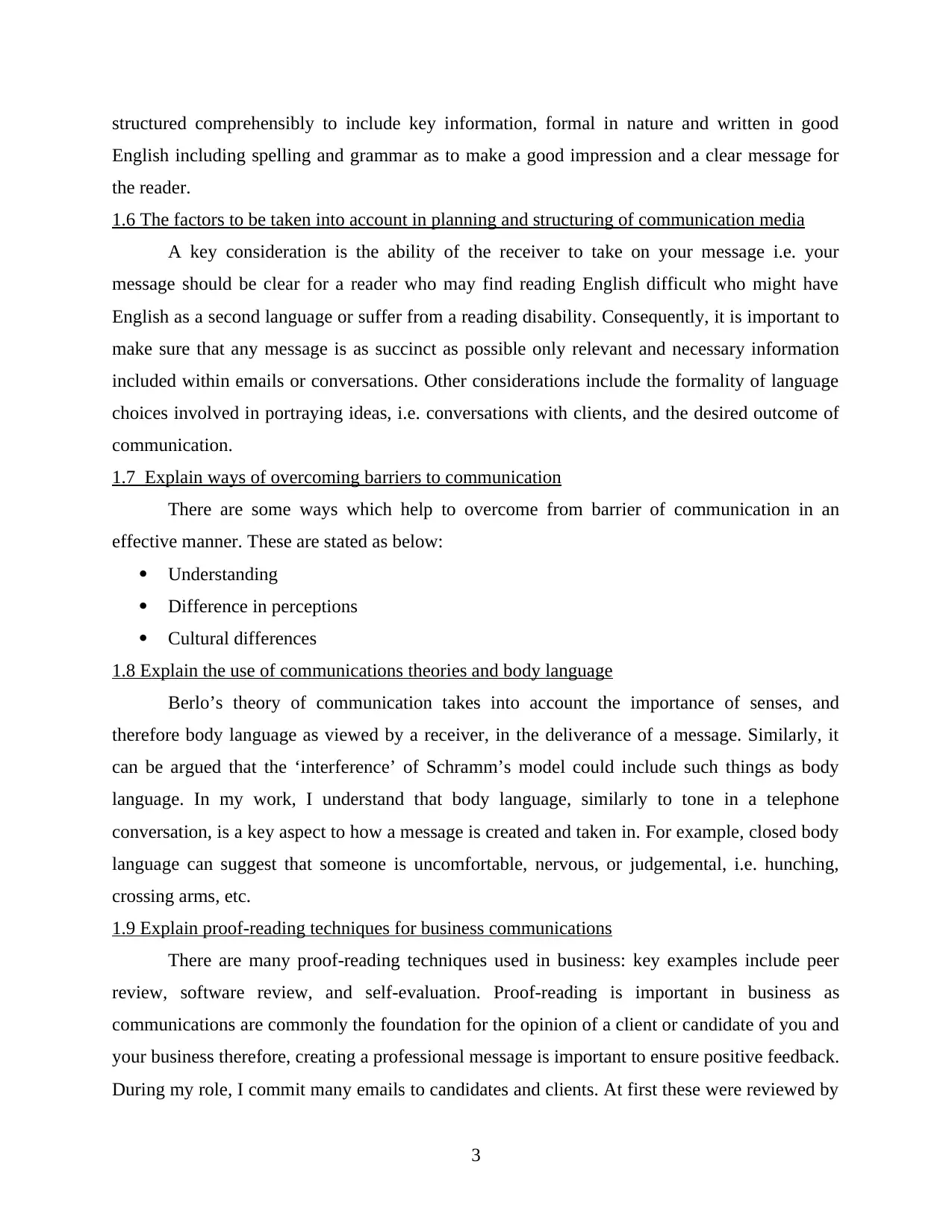
structured comprehensibly to include key information, formal in nature and written in good
English including spelling and grammar as to make a good impression and a clear message for
the reader.
1.6 The factors to be taken into account in planning and structuring of communication media
A key consideration is the ability of the receiver to take on your message i.e. your
message should be clear for a reader who may find reading English difficult who might have
English as a second language or suffer from a reading disability. Consequently, it is important to
make sure that any message is as succinct as possible only relevant and necessary information
included within emails or conversations. Other considerations include the formality of language
choices involved in portraying ideas, i.e. conversations with clients, and the desired outcome of
communication.
1.7 Explain ways of overcoming barriers to communication
There are some ways which help to overcome from barrier of communication in an
effective manner. These are stated as below:
Understanding
Difference in perceptions
Cultural differences
1.8 Explain the use of communications theories and body language
Berlo’s theory of communication takes into account the importance of senses, and
therefore body language as viewed by a receiver, in the deliverance of a message. Similarly, it
can be argued that the ‘interference’ of Schramm’s model could include such things as body
language. In my work, I understand that body language, similarly to tone in a telephone
conversation, is a key aspect to how a message is created and taken in. For example, closed body
language can suggest that someone is uncomfortable, nervous, or judgemental, i.e. hunching,
crossing arms, etc.
1.9 Explain proof-reading techniques for business communications
There are many proof-reading techniques used in business: key examples include peer
review, software review, and self-evaluation. Proof-reading is important in business as
communications are commonly the foundation for the opinion of a client or candidate of you and
your business therefore, creating a professional message is important to ensure positive feedback.
During my role, I commit many emails to candidates and clients. At first these were reviewed by
3
English including spelling and grammar as to make a good impression and a clear message for
the reader.
1.6 The factors to be taken into account in planning and structuring of communication media
A key consideration is the ability of the receiver to take on your message i.e. your
message should be clear for a reader who may find reading English difficult who might have
English as a second language or suffer from a reading disability. Consequently, it is important to
make sure that any message is as succinct as possible only relevant and necessary information
included within emails or conversations. Other considerations include the formality of language
choices involved in portraying ideas, i.e. conversations with clients, and the desired outcome of
communication.
1.7 Explain ways of overcoming barriers to communication
There are some ways which help to overcome from barrier of communication in an
effective manner. These are stated as below:
Understanding
Difference in perceptions
Cultural differences
1.8 Explain the use of communications theories and body language
Berlo’s theory of communication takes into account the importance of senses, and
therefore body language as viewed by a receiver, in the deliverance of a message. Similarly, it
can be argued that the ‘interference’ of Schramm’s model could include such things as body
language. In my work, I understand that body language, similarly to tone in a telephone
conversation, is a key aspect to how a message is created and taken in. For example, closed body
language can suggest that someone is uncomfortable, nervous, or judgemental, i.e. hunching,
crossing arms, etc.
1.9 Explain proof-reading techniques for business communications
There are many proof-reading techniques used in business: key examples include peer
review, software review, and self-evaluation. Proof-reading is important in business as
communications are commonly the foundation for the opinion of a client or candidate of you and
your business therefore, creating a professional message is important to ensure positive feedback.
During my role, I commit many emails to candidates and clients. At first these were reviewed by
3
⊘ This is a preview!⊘
Do you want full access?
Subscribe today to unlock all pages.

Trusted by 1+ million students worldwide
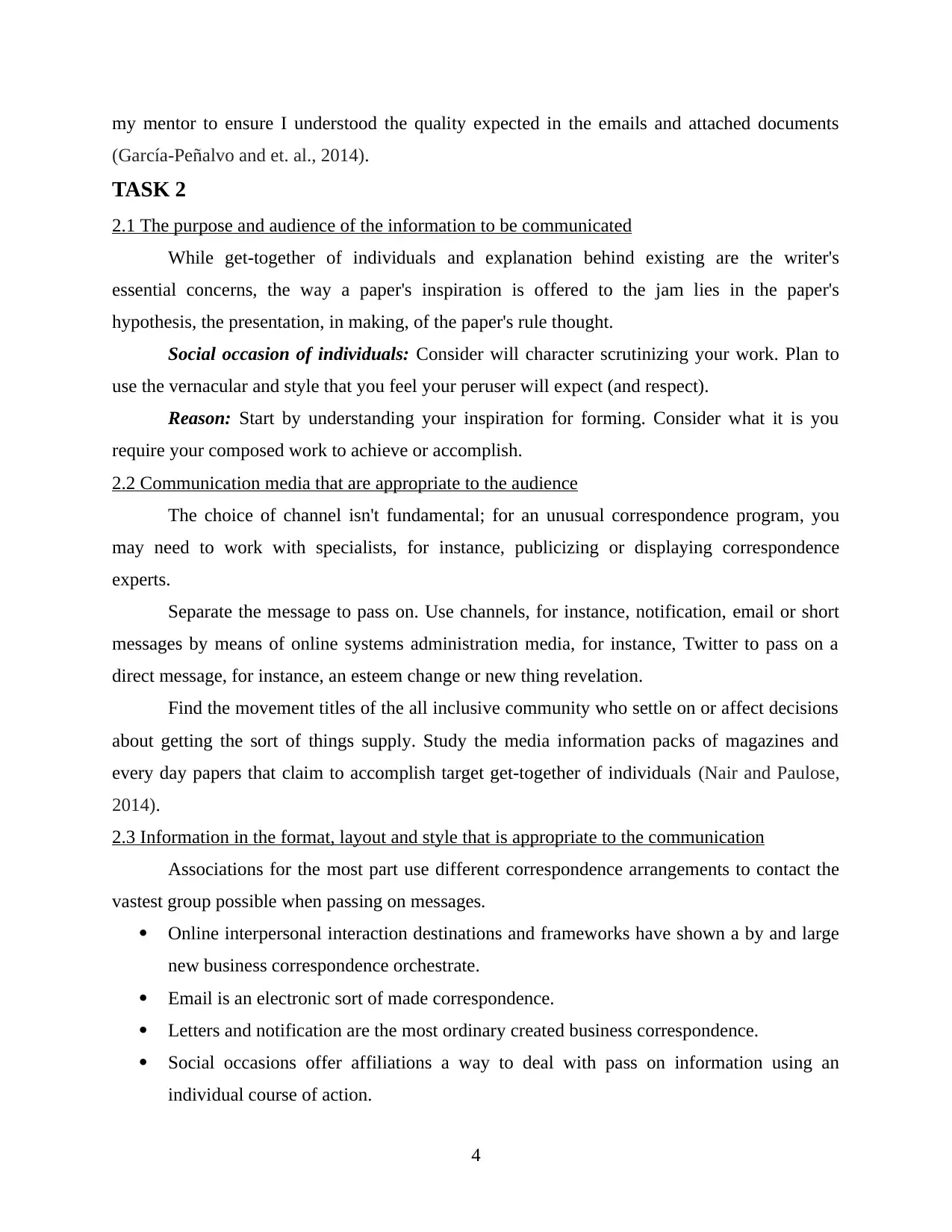
my mentor to ensure I understood the quality expected in the emails and attached documents
(García-Peñalvo and et. al., 2014).
TASK 2
2.1 The purpose and audience of the information to be communicated
While get-together of individuals and explanation behind existing are the writer's
essential concerns, the way a paper's inspiration is offered to the jam lies in the paper's
hypothesis, the presentation, in making, of the paper's rule thought.
Social occasion of individuals: Consider will character scrutinizing your work. Plan to
use the vernacular and style that you feel your peruser will expect (and respect).
Reason: Start by understanding your inspiration for forming. Consider what it is you
require your composed work to achieve or accomplish.
2.2 Communication media that are appropriate to the audience
The choice of channel isn't fundamental; for an unusual correspondence program, you
may need to work with specialists, for instance, publicizing or displaying correspondence
experts.
Separate the message to pass on. Use channels, for instance, notification, email or short
messages by means of online systems administration media, for instance, Twitter to pass on a
direct message, for instance, an esteem change or new thing revelation.
Find the movement titles of the all inclusive community who settle on or affect decisions
about getting the sort of things supply. Study the media information packs of magazines and
every day papers that claim to accomplish target get-together of individuals (Nair and Paulose,
2014).
2.3 Information in the format, layout and style that is appropriate to the communication
Associations for the most part use different correspondence arrangements to contact the
vastest group possible when passing on messages.
Online interpersonal interaction destinations and frameworks have shown a by and large
new business correspondence orchestrate.
Email is an electronic sort of made correspondence.
Letters and notification are the most ordinary created business correspondence.
Social occasions offer affiliations a way to deal with pass on information using an
individual course of action.
4
(García-Peñalvo and et. al., 2014).
TASK 2
2.1 The purpose and audience of the information to be communicated
While get-together of individuals and explanation behind existing are the writer's
essential concerns, the way a paper's inspiration is offered to the jam lies in the paper's
hypothesis, the presentation, in making, of the paper's rule thought.
Social occasion of individuals: Consider will character scrutinizing your work. Plan to
use the vernacular and style that you feel your peruser will expect (and respect).
Reason: Start by understanding your inspiration for forming. Consider what it is you
require your composed work to achieve or accomplish.
2.2 Communication media that are appropriate to the audience
The choice of channel isn't fundamental; for an unusual correspondence program, you
may need to work with specialists, for instance, publicizing or displaying correspondence
experts.
Separate the message to pass on. Use channels, for instance, notification, email or short
messages by means of online systems administration media, for instance, Twitter to pass on a
direct message, for instance, an esteem change or new thing revelation.
Find the movement titles of the all inclusive community who settle on or affect decisions
about getting the sort of things supply. Study the media information packs of magazines and
every day papers that claim to accomplish target get-together of individuals (Nair and Paulose,
2014).
2.3 Information in the format, layout and style that is appropriate to the communication
Associations for the most part use different correspondence arrangements to contact the
vastest group possible when passing on messages.
Online interpersonal interaction destinations and frameworks have shown a by and large
new business correspondence orchestrate.
Email is an electronic sort of made correspondence.
Letters and notification are the most ordinary created business correspondence.
Social occasions offer affiliations a way to deal with pass on information using an
individual course of action.
4
Paraphrase This Document
Need a fresh take? Get an instant paraphrase of this document with our AI Paraphraser
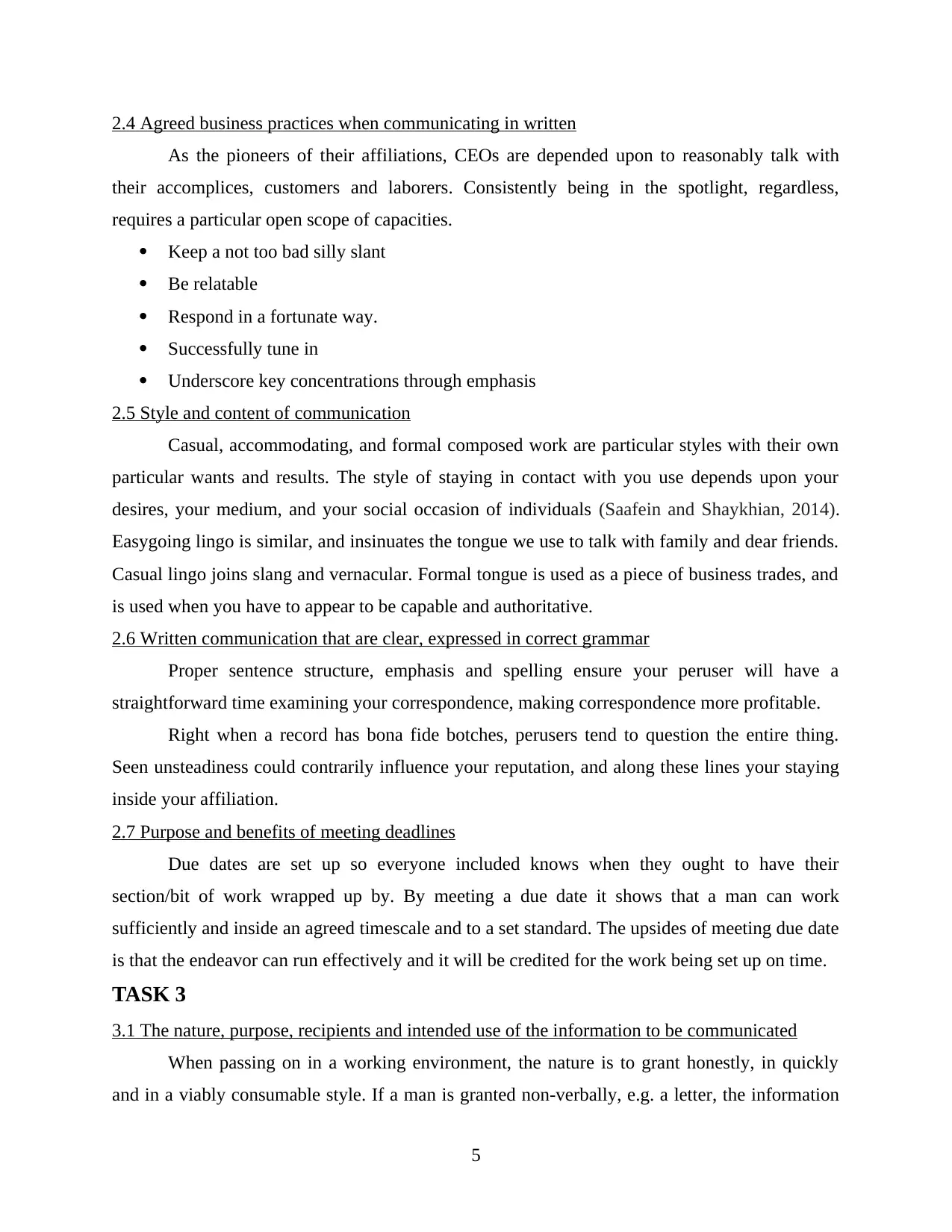
2.4 Agreed business practices when communicating in written
As the pioneers of their affiliations, CEOs are depended upon to reasonably talk with
their accomplices, customers and laborers. Consistently being in the spotlight, regardless,
requires a particular open scope of capacities.
Keep a not too bad silly slant
Be relatable
Respond in a fortunate way.
Successfully tune in
Underscore key concentrations through emphasis
2.5 Style and content of communication
Casual, accommodating, and formal composed work are particular styles with their own
particular wants and results. The style of staying in contact with you use depends upon your
desires, your medium, and your social occasion of individuals (Saafein and Shaykhian, 2014).
Easygoing lingo is similar, and insinuates the tongue we use to talk with family and dear friends.
Casual lingo joins slang and vernacular. Formal tongue is used as a piece of business trades, and
is used when you have to appear to be capable and authoritative.
2.6 Written communication that are clear, expressed in correct grammar
Proper sentence structure, emphasis and spelling ensure your peruser will have a
straightforward time examining your correspondence, making correspondence more profitable.
Right when a record has bona fide botches, perusers tend to question the entire thing.
Seen unsteadiness could contrarily influence your reputation, and along these lines your staying
inside your affiliation.
2.7 Purpose and benefits of meeting deadlines
Due dates are set up so everyone included knows when they ought to have their
section/bit of work wrapped up by. By meeting a due date it shows that a man can work
sufficiently and inside an agreed timescale and to a set standard. The upsides of meeting due date
is that the endeavor can run effectively and it will be credited for the work being set up on time.
TASK 3
3.1 The nature, purpose, recipients and intended use of the information to be communicated
When passing on in a working environment, the nature is to grant honestly, in quickly
and in a viably consumable style. If a man is granted non-verbally, e.g. a letter, the information
5
As the pioneers of their affiliations, CEOs are depended upon to reasonably talk with
their accomplices, customers and laborers. Consistently being in the spotlight, regardless,
requires a particular open scope of capacities.
Keep a not too bad silly slant
Be relatable
Respond in a fortunate way.
Successfully tune in
Underscore key concentrations through emphasis
2.5 Style and content of communication
Casual, accommodating, and formal composed work are particular styles with their own
particular wants and results. The style of staying in contact with you use depends upon your
desires, your medium, and your social occasion of individuals (Saafein and Shaykhian, 2014).
Easygoing lingo is similar, and insinuates the tongue we use to talk with family and dear friends.
Casual lingo joins slang and vernacular. Formal tongue is used as a piece of business trades, and
is used when you have to appear to be capable and authoritative.
2.6 Written communication that are clear, expressed in correct grammar
Proper sentence structure, emphasis and spelling ensure your peruser will have a
straightforward time examining your correspondence, making correspondence more profitable.
Right when a record has bona fide botches, perusers tend to question the entire thing.
Seen unsteadiness could contrarily influence your reputation, and along these lines your staying
inside your affiliation.
2.7 Purpose and benefits of meeting deadlines
Due dates are set up so everyone included knows when they ought to have their
section/bit of work wrapped up by. By meeting a due date it shows that a man can work
sufficiently and inside an agreed timescale and to a set standard. The upsides of meeting due date
is that the endeavor can run effectively and it will be credited for the work being set up on time.
TASK 3
3.1 The nature, purpose, recipients and intended use of the information to be communicated
When passing on in a working environment, the nature is to grant honestly, in quickly
and in a viably consumable style. If a man is granted non-verbally, e.g. a letter, the information
5
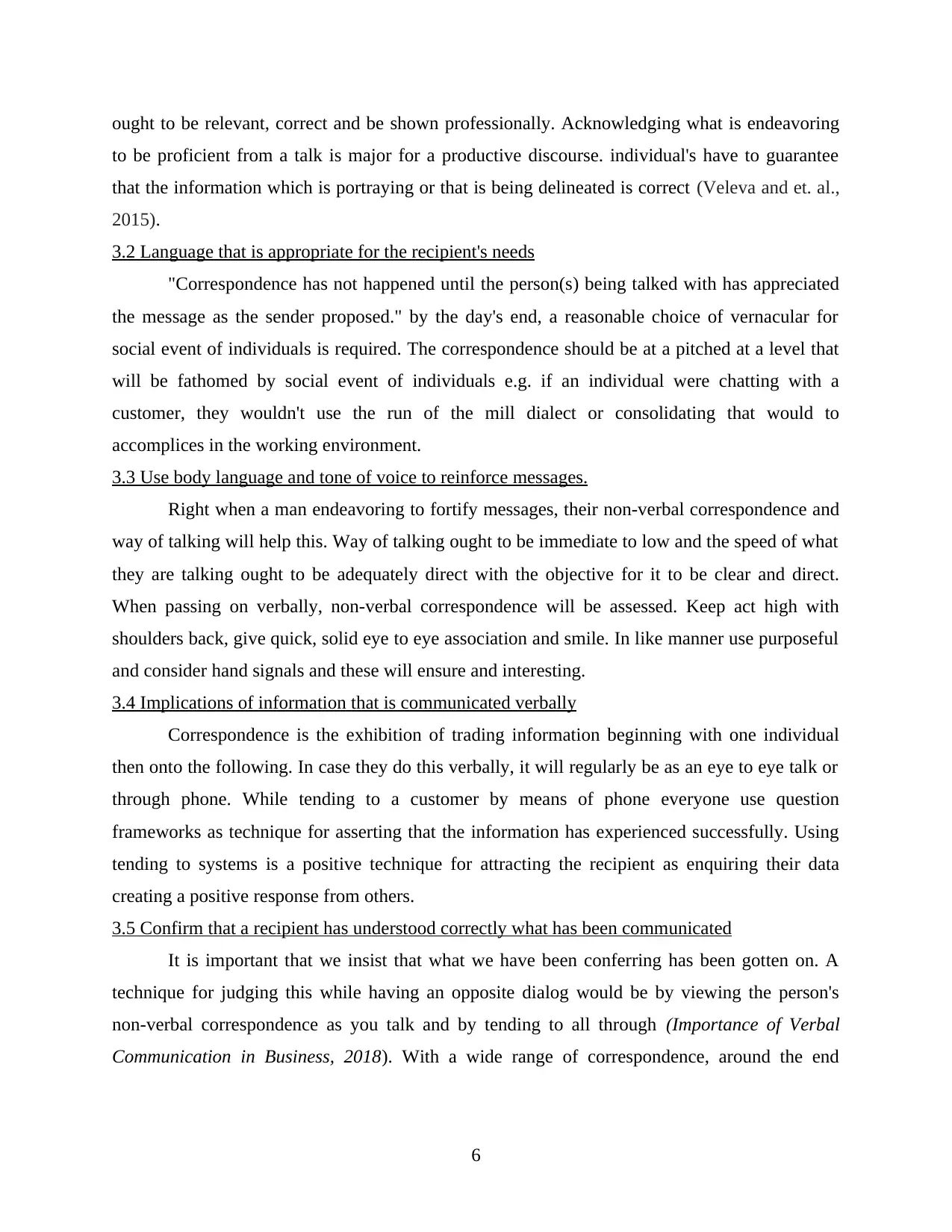
ought to be relevant, correct and be shown professionally. Acknowledging what is endeavoring
to be proficient from a talk is major for a productive discourse. individual's have to guarantee
that the information which is portraying or that is being delineated is correct (Veleva and et. al.,
2015).
3.2 Language that is appropriate for the recipient's needs
"Correspondence has not happened until the person(s) being talked with has appreciated
the message as the sender proposed." by the day's end, a reasonable choice of vernacular for
social event of individuals is required. The correspondence should be at a pitched at a level that
will be fathomed by social event of individuals e.g. if an individual were chatting with a
customer, they wouldn't use the run of the mill dialect or consolidating that would to
accomplices in the working environment.
3.3 Use body language and tone of voice to reinforce messages.
Right when a man endeavoring to fortify messages, their non-verbal correspondence and
way of talking will help this. Way of talking ought to be immediate to low and the speed of what
they are talking ought to be adequately direct with the objective for it to be clear and direct.
When passing on verbally, non-verbal correspondence will be assessed. Keep act high with
shoulders back, give quick, solid eye to eye association and smile. In like manner use purposeful
and consider hand signals and these will ensure and interesting.
3.4 Implications of information that is communicated verbally
Correspondence is the exhibition of trading information beginning with one individual
then onto the following. In case they do this verbally, it will regularly be as an eye to eye talk or
through phone. While tending to a customer by means of phone everyone use question
frameworks as technique for asserting that the information has experienced successfully. Using
tending to systems is a positive technique for attracting the recipient as enquiring their data
creating a positive response from others.
3.5 Confirm that a recipient has understood correctly what has been communicated
It is important that we insist that what we have been conferring has been gotten on. A
technique for judging this while having an opposite dialog would be by viewing the person's
non-verbal correspondence as you talk and by tending to all through (Importance of Verbal
Communication in Business, 2018). With a wide range of correspondence, around the end
6
to be proficient from a talk is major for a productive discourse. individual's have to guarantee
that the information which is portraying or that is being delineated is correct (Veleva and et. al.,
2015).
3.2 Language that is appropriate for the recipient's needs
"Correspondence has not happened until the person(s) being talked with has appreciated
the message as the sender proposed." by the day's end, a reasonable choice of vernacular for
social event of individuals is required. The correspondence should be at a pitched at a level that
will be fathomed by social event of individuals e.g. if an individual were chatting with a
customer, they wouldn't use the run of the mill dialect or consolidating that would to
accomplices in the working environment.
3.3 Use body language and tone of voice to reinforce messages.
Right when a man endeavoring to fortify messages, their non-verbal correspondence and
way of talking will help this. Way of talking ought to be immediate to low and the speed of what
they are talking ought to be adequately direct with the objective for it to be clear and direct.
When passing on verbally, non-verbal correspondence will be assessed. Keep act high with
shoulders back, give quick, solid eye to eye association and smile. In like manner use purposeful
and consider hand signals and these will ensure and interesting.
3.4 Implications of information that is communicated verbally
Correspondence is the exhibition of trading information beginning with one individual
then onto the following. In case they do this verbally, it will regularly be as an eye to eye talk or
through phone. While tending to a customer by means of phone everyone use question
frameworks as technique for asserting that the information has experienced successfully. Using
tending to systems is a positive technique for attracting the recipient as enquiring their data
creating a positive response from others.
3.5 Confirm that a recipient has understood correctly what has been communicated
It is important that we insist that what we have been conferring has been gotten on. A
technique for judging this while having an opposite dialog would be by viewing the person's
non-verbal correspondence as you talk and by tending to all through (Importance of Verbal
Communication in Business, 2018). With a wide range of correspondence, around the end
6
⊘ This is a preview!⊘
Do you want full access?
Subscribe today to unlock all pages.

Trusted by 1+ million students worldwide
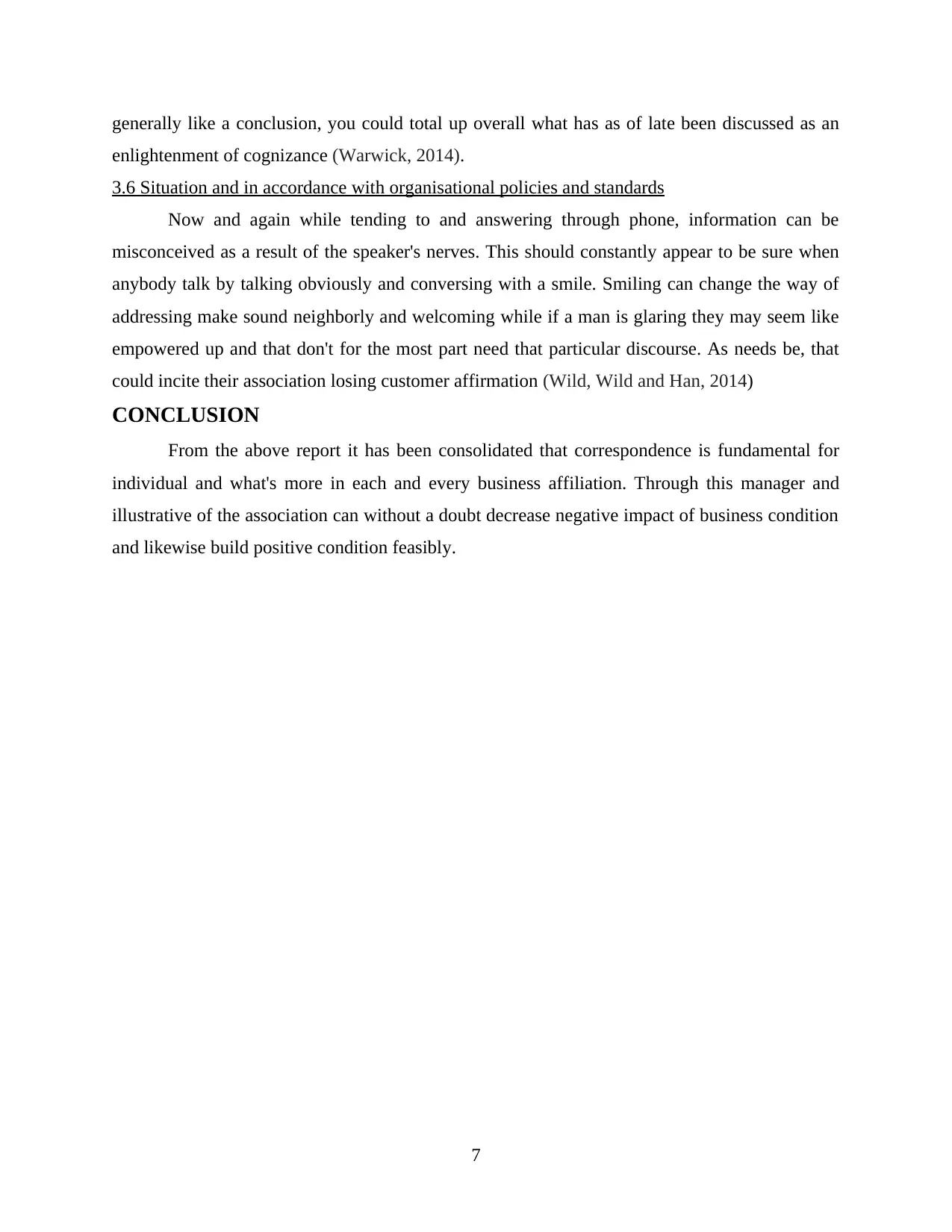
generally like a conclusion, you could total up overall what has as of late been discussed as an
enlightenment of cognizance (Warwick, 2014).
3.6 Situation and in accordance with organisational policies and standards
Now and again while tending to and answering through phone, information can be
misconceived as a result of the speaker's nerves. This should constantly appear to be sure when
anybody talk by talking obviously and conversing with a smile. Smiling can change the way of
addressing make sound neighborly and welcoming while if a man is glaring they may seem like
empowered up and that don't for the most part need that particular discourse. As needs be, that
could incite their association losing customer affirmation (Wild, Wild and Han, 2014)
CONCLUSION
From the above report it has been consolidated that correspondence is fundamental for
individual and what's more in each and every business affiliation. Through this manager and
illustrative of the association can without a doubt decrease negative impact of business condition
and likewise build positive condition feasibly.
7
enlightenment of cognizance (Warwick, 2014).
3.6 Situation and in accordance with organisational policies and standards
Now and again while tending to and answering through phone, information can be
misconceived as a result of the speaker's nerves. This should constantly appear to be sure when
anybody talk by talking obviously and conversing with a smile. Smiling can change the way of
addressing make sound neighborly and welcoming while if a man is glaring they may seem like
empowered up and that don't for the most part need that particular discourse. As needs be, that
could incite their association losing customer affirmation (Wild, Wild and Han, 2014)
CONCLUSION
From the above report it has been consolidated that correspondence is fundamental for
individual and what's more in each and every business affiliation. Through this manager and
illustrative of the association can without a doubt decrease negative impact of business condition
and likewise build positive condition feasibly.
7
Paraphrase This Document
Need a fresh take? Get an instant paraphrase of this document with our AI Paraphraser
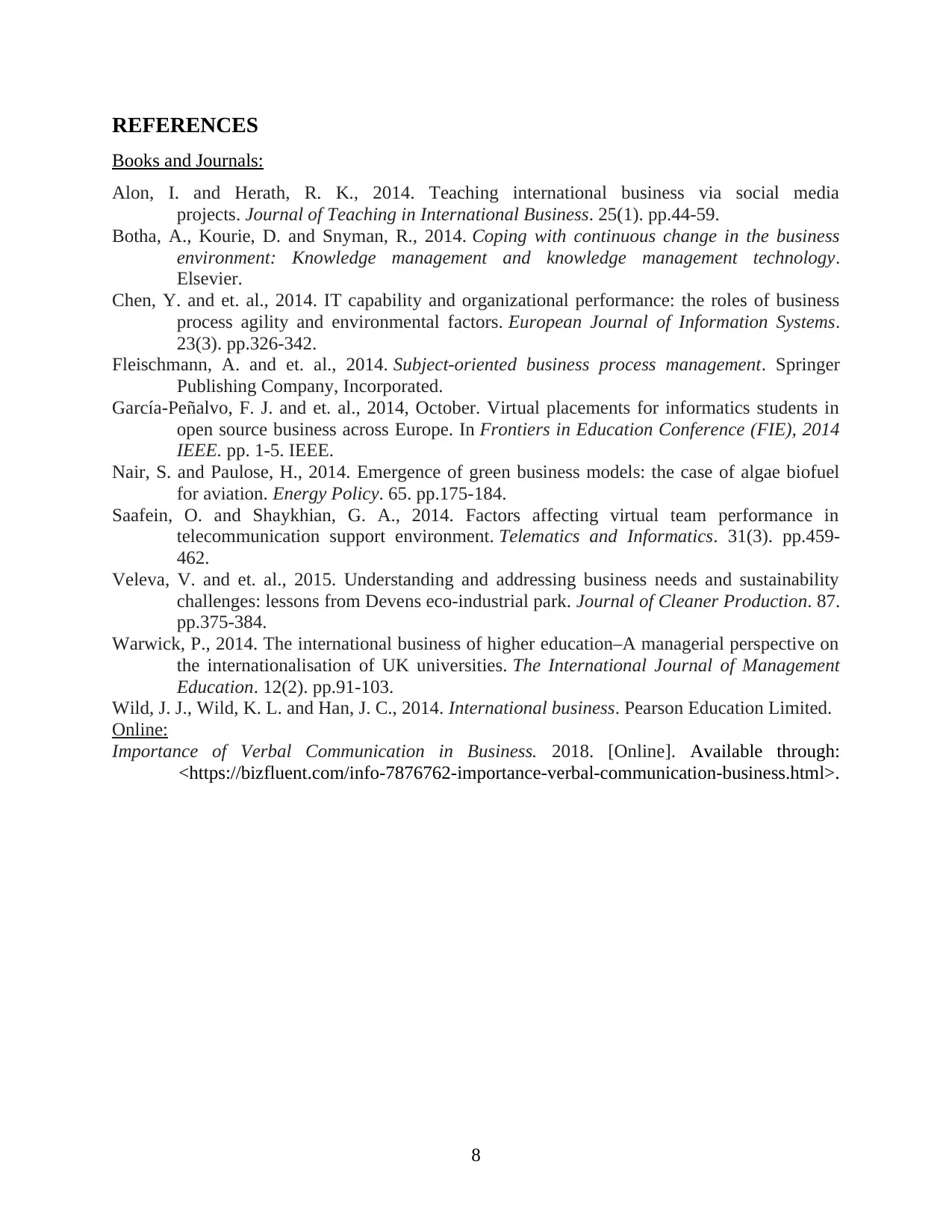
REFERENCES
Books and Journals:
Alon, I. and Herath, R. K., 2014. Teaching international business via social media
projects. Journal of Teaching in International Business. 25(1). pp.44-59.
Botha, A., Kourie, D. and Snyman, R., 2014. Coping with continuous change in the business
environment: Knowledge management and knowledge management technology.
Elsevier.
Chen, Y. and et. al., 2014. IT capability and organizational performance: the roles of business
process agility and environmental factors. European Journal of Information Systems.
23(3). pp.326-342.
Fleischmann, A. and et. al., 2014. Subject-oriented business process management. Springer
Publishing Company, Incorporated.
García-Peñalvo, F. J. and et. al., 2014, October. Virtual placements for informatics students in
open source business across Europe. In Frontiers in Education Conference (FIE), 2014
IEEE. pp. 1-5. IEEE.
Nair, S. and Paulose, H., 2014. Emergence of green business models: the case of algae biofuel
for aviation. Energy Policy. 65. pp.175-184.
Saafein, O. and Shaykhian, G. A., 2014. Factors affecting virtual team performance in
telecommunication support environment. Telematics and Informatics. 31(3). pp.459-
462.
Veleva, V. and et. al., 2015. Understanding and addressing business needs and sustainability
challenges: lessons from Devens eco-industrial park. Journal of Cleaner Production. 87.
pp.375-384.
Warwick, P., 2014. The international business of higher education–A managerial perspective on
the internationalisation of UK universities. The International Journal of Management
Education. 12(2). pp.91-103.
Wild, J. J., Wild, K. L. and Han, J. C., 2014. International business. Pearson Education Limited.
Online:
Importance of Verbal Communication in Business. 2018. [Online]. Available through:
<https://bizfluent.com/info-7876762-importance-verbal-communication-business.html>.
8
Books and Journals:
Alon, I. and Herath, R. K., 2014. Teaching international business via social media
projects. Journal of Teaching in International Business. 25(1). pp.44-59.
Botha, A., Kourie, D. and Snyman, R., 2014. Coping with continuous change in the business
environment: Knowledge management and knowledge management technology.
Elsevier.
Chen, Y. and et. al., 2014. IT capability and organizational performance: the roles of business
process agility and environmental factors. European Journal of Information Systems.
23(3). pp.326-342.
Fleischmann, A. and et. al., 2014. Subject-oriented business process management. Springer
Publishing Company, Incorporated.
García-Peñalvo, F. J. and et. al., 2014, October. Virtual placements for informatics students in
open source business across Europe. In Frontiers in Education Conference (FIE), 2014
IEEE. pp. 1-5. IEEE.
Nair, S. and Paulose, H., 2014. Emergence of green business models: the case of algae biofuel
for aviation. Energy Policy. 65. pp.175-184.
Saafein, O. and Shaykhian, G. A., 2014. Factors affecting virtual team performance in
telecommunication support environment. Telematics and Informatics. 31(3). pp.459-
462.
Veleva, V. and et. al., 2015. Understanding and addressing business needs and sustainability
challenges: lessons from Devens eco-industrial park. Journal of Cleaner Production. 87.
pp.375-384.
Warwick, P., 2014. The international business of higher education–A managerial perspective on
the internationalisation of UK universities. The International Journal of Management
Education. 12(2). pp.91-103.
Wild, J. J., Wild, K. L. and Han, J. C., 2014. International business. Pearson Education Limited.
Online:
Importance of Verbal Communication in Business. 2018. [Online]. Available through:
<https://bizfluent.com/info-7876762-importance-verbal-communication-business.html>.
8
1 out of 11
Related Documents
Your All-in-One AI-Powered Toolkit for Academic Success.
+13062052269
info@desklib.com
Available 24*7 on WhatsApp / Email
![[object Object]](/_next/static/media/star-bottom.7253800d.svg)
Unlock your academic potential
Copyright © 2020–2025 A2Z Services. All Rights Reserved. Developed and managed by ZUCOL.





